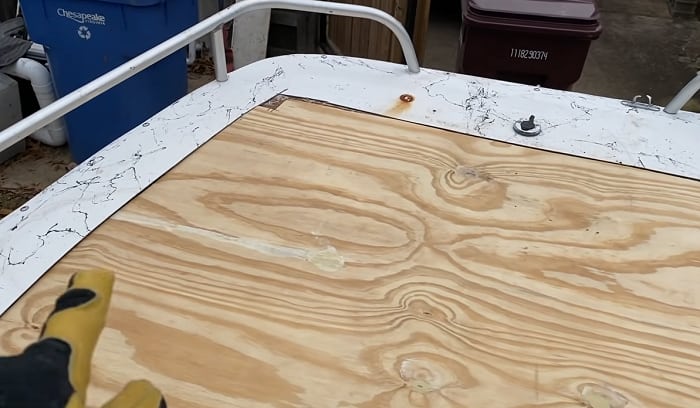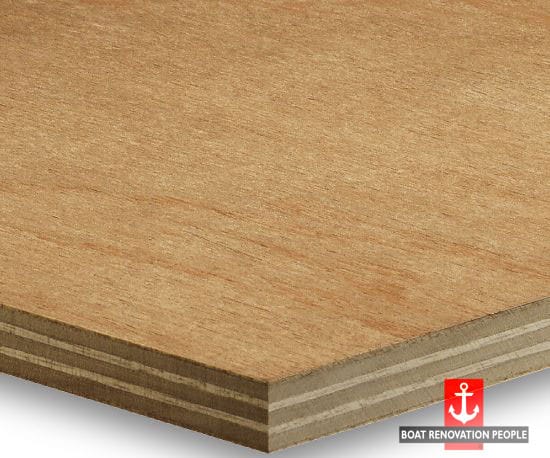Ahoy there! Decking out a boat can be an exciting adventure, especially when it comes to choosing the right plywood for the boat floor. So, what kind of plywood should you use? Well, let’s dive right in and find out!
When it comes to selecting the perfect plywood for your boat floor, durability and water resistance are the name of the game. You want a material that can withstand the unpredictable elements of the open sea while providing a sturdy foundation for your nautical adventures.
But don’t fret, young sailor! In this guide, we’ll explore the different types of plywood available and help you navigate the waters of boat flooring. Whether you’re a seasoned sailor or a landlubber just starting out, we’ve got you covered. So grab your life jacket and let’s set sail on this plywood voyage together!

What Kind of Plywood is Best for a Boat Floor?
Choosing the right plywood for your boat floor is crucial to ensure its strength, durability, and overall performance. With so many options available, it can be overwhelming to determine which type is best suited for your boat. In this article, we will explore the different types of plywood commonly used for boat floors and discuss their qualities, benefits, and drawbacks. By the end, you’ll have a better understanding of what kind of plywood you should choose to create a sturdy and reliable boat floor.
Marine-Grade Plywood
Marine-grade plywood is specifically designed for boat applications, making it the top choice for boat floors. It is built with high-quality veneers and a solid core that is made to withstand moisture and harsh marine environments. Marine-grade plywood is constructed using a waterproof adhesive, ensuring that it remains durable even when exposed to water for extended periods.
The main advantage of marine-grade plywood is its excellent resistance to rot, warping, and delamination. It also provides superior strength, making it ideal for supporting heavy loads on a boat floor. Marine-grade plywood is available in different thicknesses and can be easily cut and shaped to fit any boat floor design. While marine-grade plywood can be more expensive than other options, its longevity and reliability outweigh the upfront cost.
Exterior-Grade Plywood
Exterior-grade plywood is another viable option for boat floors. It is designed to withstand outdoor conditions and is often used for construction purposes. While not specifically made for marine use, exterior-grade plywood can still offer good durability and resilience. However, it is important to note that exterior-grade plywood does not have the same level of water resistance as marine-grade plywood.
One advantage of exterior-grade plywood is its affordability compared to marine-grade plywood. It is readily available and can be easily sourced from local hardware stores. When using exterior-grade plywood for boat floors, it is recommended to apply a waterproofing sealant or coat it with fiberglass to enhance its water resistance and protect against rotting or warping.
Pressure-Treated Plywood
Pressure-treated plywood is treated with chemicals that make it more resistant to rot, insects, and decay. It is commonly used for outdoor and marine applications, including boat floors. Pressure-treated plywood is an economical choice for boat owners looking for a budget-friendly option that offers decent durability.
While pressure-treated plywood provides some level of water resistance, it is important to note that it may not be as effective as marine-grade plywood. Therefore, it is recommended to use a waterproofing agent or sealant to further enhance its resistance to moisture and prolong its lifespan. Additionally, it’s crucial to avoid using pressure-treated plywood in areas where it may come into direct contact with aluminum or other metals, as the chemicals in the plywood can cause corrosion.
Other Options to Consider: Fir, Spruce, and Okoume Plywood
In addition to marine-grade, exterior-grade, and pressure-treated plywood, there are a few other options to consider for boat floors. Fir plywood is known for its strength and durability, as well as its ability to resist moisture. Spruce plywood, on the other hand, is lightweight and flexible, making it a popular choice for boat building. Okoume plywood is also commonly used for boat floors due to its excellent strength-to-weight ratio and resistance to decay.
When considering these alternatives, it is important to assess their specific qualities and determine whether they meet your boat floor requirements. Always prioritize durability, water resistance, and strength when making your decision.
Benefits of Using the Right Plywood for Your Boat Floor
Making the right choice when it comes to the plywood for your boat floor can offer a range of benefits.
Increased Durability
Using the correct plywood, such as marine-grade or exterior-grade, will ensure that your boat floor withstands the test of time. These types of plywood are designed to resist rotting, warping, and delamination, ensuring that your boat floor remains structurally sound for years to come.
Enhanced Water Resistance
Boats are constantly exposed to moisture, whether it’s from the water, rain, or humidity. Choosing plywood that is specifically made to resist water, such as marine-grade plywood, will prevent it from damage caused by water absorption. This added water resistance will help prevent rot, decay, and mold growth, extending the lifespan of your boat floor.
Improved Strength
The right plywood choice will provide the necessary strength to support heavy loads on your boat floor. Whether you’re carrying equipment, passengers, or engaging in water activities, having a strong and reliable boat floor is essential for safety and performance.
Cost Efficiency
Investing in high-quality plywood upfront may seem like a larger expense, but it can save you money in the long run. Durability and resistance to damage mean fewer repairs and replacements, reducing overall maintenance costs. Additionally, using the right plywood can be more cost-effective than using alternatives that may require additional treatments or coatings to achieve the desired level of water resistance.
Tips for Choosing and Maintaining Your Boat Floor Plywood
Consider Your Boat’s Specific Needs
Every boat is unique, and different types of plywood may be more suitable depending on size, intended use, and environmental conditions. Consider factors such as the level of water exposure, load-bearing requirements, and your budget before making a decision.
Inspect Regularly for Signs of Damage
To ensure the longevity and safety of your boat floor, make it a habit to inspect it regularly for any signs of damage, such as warping, soft spots, or delamination. Catching issues early on will allow for timely repairs and prevent further damage.
Apply Protective Coatings
If you choose plywood other than marine-grade for your boat floor, it is advisable to apply a waterproofing sealant or coat it with fiberglass resin to enhance its water resistance. Follow the manufacturer’s instructions carefully and reapply the protective coating as needed.
Keep the Boat Floor Clean and Dry
After each use, clean your boat floor and ensure it is dry before storing your boat. This will prevent moisture from accumulating and causing damage over time, such as rot or mold growth.
Key Takeaways: What Kind of Plywood for Boat Floor?
- Marine-grade plywood is the best option for boat flooring due to its durability and waterproof properties.
- Choose plywood that is specifically designed for marine applications to ensure it can withstand constant exposure to water.
- Look for plywood with a solid core, free of voids or gaps, to ensure it is strong enough to support the weight and stress of the boat.
- Consider the thickness of the plywood based on the size and type of boat to determine its load-bearing capacity.
- Properly seal and finish the plywood to protect it from moisture and extend its lifespan.
Frequently Asked Questions
When it comes to choosing the right plywood for a boat floor, there are several factors to consider. We’ve compiled a list of common questions to help you make an informed decision.
Q1: How important is the type of plywood used for a boat floor?
Choosing the right plywood for your boat floor is crucial for its structural integrity and longevity. Marine plywood, specifically designed for water-based applications, is highly recommended. Unlike regular plywood, marine plywood is water-resistant, making it resistant to warping, rot, and delamination.
Marine plywood is made of high-quality veneer and bonded with waterproof glue, ensuring that it can withstand the wet conditions encountered on a boat. It also has fewer voids, adding to its strength, and is generally built to meet strict quality standards, giving you peace of mind.
Q2: Can I use regular plywood instead of marine plywood for a boat floor?
While regular plywood may seem like a cost-effective alternative, it is not recommended for boat floors. Regular plywood is not designed to withstand the constant exposure to moisture and can quickly deteriorate when used in a marine environment. It is more prone to warping, rotting, and delamination, which can compromise the structural integrity of your boat.
Using marine plywood is an investment in the longevity and safety of your boat. It ensures that your boat floor remains strong and reliable, even in harsh water conditions, allowing you to enjoy your time on the water without worry.
Q3: Are there different grades of marine plywood for boat floors?
Yes, marine plywood comes in different grades, and the choice depends on your specific needs and budget. The most common grades are A, B, and C. Grade A is the highest quality, with no knots or defects on the face veneers. Grade B may have some knots but is still suitable for boat floors. Grade C allows for more defects but is still made with waterproof glue and can be used for less visible areas.
It’s best to consult with a marine professional or boat builder to determine the appropriate grade of marine plywood for your specific boat flooring needs.
Q4: How thick should the plywood be for a boat floor?
The thickness of the plywood for your boat floor depends on several factors, including the size of the boat and the anticipated load it will carry. In general, a thickness of ⅝ to ¾ inches (16-19mm) is commonly used for smaller boats, while larger boats may require thicker plywood, such as ¾ to 1 inch (19-25mm).
It’s important to consider the weight distribution, intended use of the boat, and any specific requirements or recommendations provided by the boat manufacturer or a marine professional before finalizing the thickness of the plywood.
Q5: Can I modify marine plywood for a custom boat floor shape?
Yes, marine plywood can be modified to fit custom boat floor shapes. Marine plywood is known for its flexibility and ease of shaping. It can be cut, shaped, and sanded to match the specific contours required for your boat floor.
However, it’s essential to ensure that any modifications maintain the structural integrity of the plywood. Avoid cutting or modifying any vital areas that could weaken the boat floor, and always follow proper cutting and installation techniques recommended by professionals or boat manufacturers.

Summary
When choosing plywood for a boat floor, it’s important to consider its type and quality. Marine-grade plywood is the best option as it is specifically designed for boat construction and has superior water resistance. Avoid using regular interior or exterior plywood, as they are not as durable and can rot when exposed to water. Look for plywood that is labeled as “BS 1088” or “AB Marine Grade” for the highest quality. Additionally, applying a waterproof sealant can further protect the plywood from water damage.
Remember to properly measure and cut the plywood to fit the boat floor, ensuring a snug fit. It’s also a good idea to periodically check the condition of the plywood for any signs of wear or damage and replace it if necessary. Taking these steps will help ensure a strong and long-lasting boat floor that can withstand the demands of boating and keep you safe on the water.
